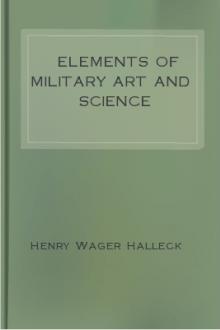Elements of Military Art and Science by Henry Wager Halleck (books you have to read txt) 📕

- Author: Henry Wager Halleck
- Performer: -
Book online «Elements of Military Art and Science by Henry Wager Halleck (books you have to read txt) 📕». Author Henry Wager Halleck
Having already described the general influence of permanent fortifications as a means of national defence, we shall here speak merely of the principles of their construction. It is not proposed to enter into any technical discussion of matters that especially belong to the instruction of the engineer, but merely to give the nomenclature and use of the more important parts of a military work; in a word, such general information as should belong to officers of every grade and corps of an army.
The first species of fortification among the ancients was of course very simple, consisting merely of an earthen mound, or palisades. A wall was afterwards used, and a ditch was then added to the wall. It was found that a straight wall could be easily breached by the enemy's battering-rams; to remedy this evil, towers were built at short intervals from each other, forming a broken line of salient and re-entering parts. These towers or salient points gradually assumed a shape approximating to the modern bastion.
After the invention of gunpowder and the application of cannon to the attack and defence of places, it became necessary to arrange earthen ramparts behind the thin walls of the ancient works, for the reception of the new artillery. Moreover these walls were soon found inadequate to resist the missiles of the besiegers, and it became necessary to replace them by parapets of earth. In order to cover the retaining walls of these parapets from the besieging batteries, it was also found to be necessary to lower these walls as much as possible, and to raise the counterscarps. The traces or plans of the works, however, received no material change till about the close of the fifteenth century.
It is not known who first changed the ancient towers into bastions. Some attribute it to an Italian, and with considerable show of reason, for a bastion was built at Turin as early as 1461. Achmet Pacha, it is said, fortified Otranto in this way, in 1480, but whether the system was previously known among the Turks cannot be determined. Others attribute the invention to Ziska, the celebrated leader of the Hussites. It is most probable that the transition from the tower to the bastion was a very gradual one, and that the change was perfected in several countries at about the same time.
Fortifications, like other arts and sciences, greatly flourished in Italy under the Medicis, and that country furnished Europe with its most skilful engineers. Catharine of Medicis introduced into France many of her countrymen, distinguished in this profession; among these may be named Bellamat, Bephano, Costritio, Relogio, Vorganno, the two Marini, Campi, and Hieronimo, who built several important places and directed the sieges of others. These able foreigners were rivalled by some distinguished French engineers, who laid the foundation of the "corps du Genie" which has since become a school of military instruction for the world. Among the early French engineers may be distinguished Lafontaine De Serré, Feuquières, and St. Remy. Pedro Navarro had been appointed a member of this corps, but his attention was more specially directed to mining, and we do not learn that he distinguished himself in the construction of any fortification.
In Germany, in the beginning of the sixteenth century, Albert Durer distinguished himself as a writer on fortification; his book is remarkable as containing the germs of many of the improvements which were made by those who followed him. This is the more to be wondered at as he was not a professed engineer. After him followed Spekel, a native of Strasburg, who died in 1589. His writings are valuable as showing the state of the art at that time, and the changes which he himself introduced. He was an engineer of much practical knowledge and experience, having assisted at the sieges of Malta, Golletta, Vienna, Jula, Nicosia, Famagusta, &c.
The first French engineer who wrote on fortification was Errard de Bar-le-Duc, who published near the close of the sixteenth century. As an engineer, he was rivalled by Chatillon, a man of distinguished merit. Errard fortified Amiens, built a part of the castle of Sedan, and a portion of the defences of Calais. Under the reign of Louis XIII., Desnoyers, Deville, Pagan, and Fabre were greatly distinguished. Deville published in 1628. He was a man of much learning and experience; but he is said to have adopted, both in his theory and practice, the principles of the Italian school, with most of its errors. Pagan began his military career while young, and became maréchal de champ at the age of 38, when, having the misfortune to become blind, he was compelled to relinquish his brilliant hopes. He was the ablest engineer of his age, and was also greatly distinguished in other branches of science. In his plans he inclined to the Dutch rather than the Italian school of fortification. He published in 1645.
At the close of the sixteenth century, the Dutch had been forced to resort to military defences to protect themselves against the aggressions of the Spaniards. As the Dutch were inferior in other military means, fortification became one of the vital resources of the country. Their works, however, thrown up in much haste, were in many respects defective, although well adapted to the exigencies of the time. Freytag, their principal engineer, wrote in 1630. Some of his improvements were introduced into France by Pagan. He was preceded by Marolois, (a cotemporary of Pagan,) who published in 1613.
In Germany, Rimpler, a Saxon, wrote on fortification in 1671. He was a man of great experience, having served at the sieges of Candia, Phillipsburg, Bonn, Riga, Bremen, Dansburg, Bommeln, &c. He fell at the siege of Vienna in 1683. His writings are said to contain the groundwork of Montalembert's system.
In Italy, after the time of Tartaglia, Marchi, Campi, &c., we find no great improvement in this art. Several Italians, however, distinguished themselves as engineers under the Spaniards. The fortifications of Badajos are a good example of the state of the art in Italy and Spain a that epoch. The citadel of Antwerp, built by two Italian engineers, Pacciotti and Cerbelloni, in 1568, has become celebrated for the siege it sustained in 1832.
The age of Louis XIV. effected a great revolution in the art of fortification, and carried it to such a degree of perfection, that it has since received but slight improvement. The years 1633 and 1634 are interesting dates in the history of this art, as having given birth respectively to Vauban and Coehorn. The former was chief engineer of France under Louis XIV., and the latter held a corresponding position under the Dutch republic. Coehorn's ideas upon fortification are conceived with an especial view to the marshy soil of his own country, and, although well suited to the object in view, are consequently of less general application than those of his more distinguished cotemporary and rival. The best specimens of his mode of construction that exist at the present day, are the fortresses of Manheim, Bergen-op-Zoom, Nimiguen, and Breda.
Coehorn was followed in Holland by Landsberg, an able and practical engineer, who to much reading added extensive experience, having himself served at sixteen sieges. His system was in many respects peculiar, both in trace and relief; it dispensed with the glacis, and all revertments of masonry. His plans could be applied only to marshy soils. The first edition of his work was published in 1685.
But the career of Vauban forms the most marked and prominent era in the history of fortification; it constitutes the connecting link between the rude sketches of the earlier engineers, and the well-established form which the art has since assumed. In his earlier works we find many of the errors of his predecessors; but a gradual change seems to have been wrought in his mind by reflection and experience, and these faults were soon remedied and a new and distinct system developed. Vauban has left no treatise upon his favorite art, and his ideas upon fortification have been deduced from his constructions, and from detached memoirs left among his papers. The nature of his labors, and the extent of his activity and industry, may be imagined from the fact that he fought one hundred and forty battles, conducted fifty-eight sieges, and built or repaired three hundred fortifications. His memoirs, found among his manuscript papers, on various military and political subjects, are numerous, and highly praised even at the present day. But his beautiful and numerous constructions, both of a civil and military character, are real monuments to his genius. The best illustrations of his principles of fortification occur at Lille, Strasbourg, Landau, Givet, and Neuf-Brisack. His writings on mines, and the attack and defence of places, are, by the profession, regarded as classic. His improvements in the existing method of attack gave great superiority to the arms of his countrymen, and even enabled him to besiege and capture his rival Coehorn, in his own works. He died in 1707, and was soon succeeded by Cormontaigne.
The latter did not attempt the introduction of any new system, but limited himself to improving and perfecting the plans of his illustrious predecessors. His improvements, however, were both extensive and judicious, and are sufficient to entitle him to the place he holds as one of the ablest military engineers the world has ever produced. His works on the subject of fortification, besides being elegantly written, contain the most valuable information of any works we have. His most admired constructions are to be found at Metz, Thionville, and Bitche. The beautiful crown works of Billecroix, at Metz, are perfect models of their kind. Cormontaigne died in 1750.
Cotemporary with him were Sturin and Glasser. The former deviated but slightly from the systems of his predecessors, but the latter invented several ingenious improvements which gave him great reputation.
Next follows Rosard, a Bavarian engineer; and Frederick Augustus, king of Poland, who devoted himself particularly to this art. The former casemated only the flanks of his works, but the latter introduced casemate fire more extensively than any one who had preceded him.
In France, Belidor and De Filey published about the middle of the last century. They were both able engineers but their systems were inferior to that of Cormontaigne.
In 1767 De la Chiche introduced a system of fortification in many respects original. He raised his covered-ways so as to conceal all his masonry, and casemated a great portion of his enceinte. For exterior defence, he employed direct fire from his barbettes, and curvated fire from his casemates; the direct fire of the latter secured his ditches.
Next to De la Chiche follows Montalembert, who published in 1776. He was a man of much experience and considerable originality, but of no great ability as an engineer. Most of his ideas were derived from De la Chiche and the German school of Rimpler. His plans have generally been rejected by his own countrymen, but they still have advocates among the Germans.
General Virgin, a distinguished Swedish engineer, wrote in 1781. His idea of strongly fortifying the smaller towns to the comparative neglect of the larger cities, constitutes one of the principal novelties in his system.
In 1794, Reveroni devised a system in which the casemates of Montalembert were employed, but his guns were so arranged as to be employed in barbette while the besiegers were at a distance, and afterwards to be used for casemated fire. The casemate gun-carriage,





Comments (0)